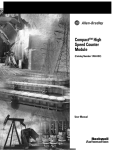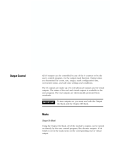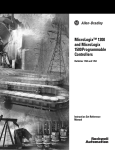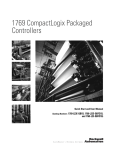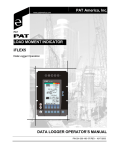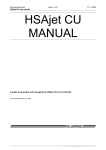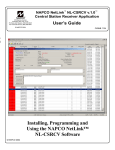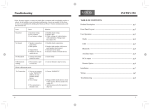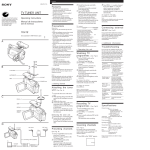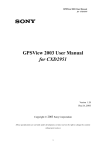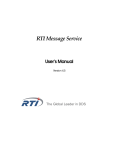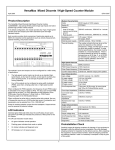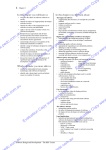Download 1769-UM006A-EN-P, Compact High Speed Counter Module User
Transcript
2-14 Module Operation Input Frequency Maximum input frequency is determined by the input configuration as shown in the table below. Input Configuration Input Frequency X4 Quadrature Encoder 250 kHz X2 Quadrature Encoder 500 kHz All Other Configurations 1 MHz See Table 2.2 for additional details. Counter Types Each of the four possible counters can be configured to stop counting and set a flag at its limits (linear counter) or to roll over and set a flag at its limits (ring counter). A counter’s limits are programmed by the CtrnMaxCount and CtrnMinCount words in the Module Configuration Array. Both types are described below. Linear Counter The figure below describes linear counter operation. In linear operation, the current count (Ctr[n].CurrentCount) value remains between, or equal to, the user-programmed minimum count (CtrnMinCount) and maximum count (CtrnMaxCount) values. If the Ctr[n].CurrentCount value would go above (>) or below (<) these values, the counter stops counting, and an overflow/underflow bit is set. The overflow/underflow bits can be reset using the CtrnResetCounterOverflow and CtrnResetCounterUnderflow bits. Figure 2.6 Linear Counter Diagram Minimum Count Value 0 Maximum Count Value Count Up Counter Value Count Down Underflow and Hold Overflow and Hold Pulses are not accumulated in an overflow/underflow state. The counter begins counting again when pulses are applied in the proper direction. For example, if you exceed the maximum by 1,000 counts, you do not need to apply 1,000 counts in the opposite direction before the counter begins counting down. The first pulse in the opposite direction decrements the counter. Module Operation 2-15 Ring Counter Figure 2.7 demonstrates ring counter operation. In ring counter operation, the current count (Ctr[n].CurrentCount) value changes between user-programmable minimum count (CtrnMinCount) and maximum count (CtrnMaxCount) values. If, when counting up, the counter reaches the CtrnMaxCount value, it rolls over to the CtrnMinCount value upon receiving the next count and sets the overflow bit. If, when counting down, the counter reaches the CtrnMinCount value, it rolls under to the CtrnMaxCount value upon receiving the next count and sets the underflow bit. These bits can be reset using the CtrnResetCounterOverflow and CtrnResetCounterUnderflow bits. Figure 2.7 Ring Counter Diagram Maximum Count Value Minimum Count Value Rollover Count Down Modifying Count Value Count Up The count value (Ctr[n].CurrentCount) can be stored, reset, or preset using the Z input, CtrReset bit in the Configuration Array, control bits in the Output Array, or written over using a Direct Write command. Table 2.7 Available Z Functions Setting For function Store(1) on rising edge of Z, store count in the Stored Count input word Hold while Z = 1, hold counter at its current value Preset/Reset on rising edge of Z, preset the count value to the value in the preset word (1) If both a store and preset function are configured, the stored count is captured before the preset operation takes place. IMPORTANT Because only the Z inputs are used for external gating and presetting, these functions are not available for Counters 2 and 3, which do not have Z inputs. All options are always available for Counters 0 and 1, regardless of input operational mode. 2-16 Module Operation Counter Enable/Disable The counter may be enabled or disabled using the CtrnEn control bit. Be aware that disabling the counter does not inhibit any current count loading functions (e.g. preset or direct write) or any Z function. Z Input Functions Store The Z input can be used to capture the current count value even when the counter is counting at full 1 MHz speed. Gate The Z inputs can be used to gate (hold) the counter at its current value regardless of incoming A or B inputs. A gating function is typically one that allows pulses to reach the counter (gate open) or not (gate closed). Z Preset Preset can be programmed to occur based on the actions of the Z input signal. Inhibit and Invert The Z input signals may be inverted and/or inhibited, depending on the user configuration of the CtrnZInvert and CtrnZInhibit output control bits. If the signal is inhibited, the invert bit is the Z signal for the actions described above. For an explanation of those bits, see Z Inv - Z Invert (CtrnZInvert) on page 4-25 and Z Inh - Z Inhibit (CtrnZInhibit) on page 4-25. Direct Write You can arbitrarily change the current count value (Ctr[n].CurrentCount) to the direct write control value (Range12To15[n].HiLimOrDirWr). This ability applies to ranges 12 through 15. The direct write value takes effect when the Load Direct Write bit (Range12To15[n].LoadDirectWrite) transitions from 0 to 1. If you attempt to preset and load direct write to a counter at the same time, only the preset (CtrnPreset) will take effect. Module Operation 2-17 Preset/Reset Preset sets the counter to a zero or non-zero value you define. Reset the counter by setting this value (CtrnPreset) to zero. Counter Reset The CtrReset bit in the Configuration Array, when set, causes the following to occur when the system transitions to Run or the Inhibit Module bit transitions to 0: • All counters are disabled and reset to zero. • The Output Array is reset to default values until the ModConfig bit is set (1). The default value for the Output Array is all zeros. • The Input Array counter Status Flags (Overflow, Underflow, RisingEdgeZ, RateValid, PresetWarning) are reset. • The Input Array counter values (Current Count(1), StoredCount, CurrentRate and PulseInterval) are also reset to zero. • All counts are lost and all outputs are turned off. IMPORTANT For the most predictable results, you may want to clear the output image of the processor BEFORE performing a counter reset (CtrReset) to the 1769-HSC module. This is because CtrReset does not change the processor’s output image. CtrReset sets the 1769-HSC module’s Output Array to all zero’s. If any bit is set to 1 in the processor’s output image, when sent to the module, it will be seen as a state transition and be acted upon. Soft Preset Preset can be programmed to occur by setting the appropriate output control bits via your control program. Setting the CtrnSoftPreset bit in the Output Array causes the counter to be preset, changing the count to the value in CtrnPreset. (1) If zero is outside the MinCount and MaxCount limits set in the Configuration Array, then the Preset value is loaded into CurrentCount instead of zero. This also causes the PresetWarning bit to be set, which, in turn, sets the GenError bit. 2-18 Module Operation Z Preset Preset can be programmed to occur based on the actions of the Z input signal. Autopreset If the module is configured such that CtrnMaxCount < Ctr[n].CurrentCount or CtrnMinCount > Ctr[n].CurrentCount, then the module will automatically change Ctr[n].CurrentCount to the CtrnPreset value and set the CtrnPresetWarning bit. Rate/Timer Functionality To ensure maximum accuracy, the module offers two different methods to calculate the rate: • Per Pulse = 1/Pulse Interval • Cyclic = Number of Pulses/User-Defined Time Interval You select the method used, depending upon the pulse speed as defined below. These are continuously available regardless of input operational mode. Pulse Interval Rate Calculation Method Pulse Interval = 100 µs Frequency = 1/100 µs = 10,000 Hz The pulse interval rate method is very accurate for slower rates, i.e. when the pulse interval (or time between pulses) is large compared to the system clock timer (1 µs). A timer is used to measure the time between two successive pulses. The inverse of this value is the pulse interval rate. The pulse interval rate cannot be read directly from the module. It needs to be calculated. The calculation can be performed in the user control program. This method is not as accurate for higher pulse rates. When the pulse interval shrinks, two factors can distort the per pulse calculation. If the pulse interval is close to the measuring timer’s clock frequency, 1 MHz, the granularity of the time increments has a greater effect on rate inaccuracy. In addition, the rate may be calculated many times over the course of a single backplane scan. As a result, the rate data






